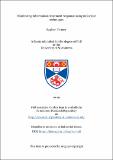Monitoring tuberculosis treatment response using molecular techniques
Abstract
This study looks to monitor tuberculosis treatment response using molecular
techniques. An assay for the detection and enumeration of Mycobacterium tuberculosis
already existed in the form of the Mycobacterial Load Assay (MBL). This utilised reverse
transcriptase quantitative polymerase chain reaction (RT-qPCR) to detect M.
tuberculosis 16S ribosomal RNA (rRNA) and thereby quantify bacillary loads in patient
sputa. By measuring labile RNA the assay was thought to only measure viable bacilli.
However, unpublished data from the Gillespie lab suggested that 16S rRNA remains
stable even once cell are non-viable. Two new markers were sought to represent the
viable bacilli: M. tuberculosis precursor 16S rRNA (pre-16S rRNA) and transfer-
messenger RNA (tm-RNA).
Both of these novel biomarkers were chosen because of their complex secondary
structures giving them increased stability allowing for their detection in adverse
environments.
Development and of a multiplex assay using the same messenger RNA (mRNA) phyB
internal control utilised by the MBL assay, then the fielding testing of these multiplex
assays was performed with the subsequent failure of the phyB control.
The internal control was then redesigned to be more robust and reproducible
utilising a novel M. marinum control. The new multiplex assays with 16S rRNA, pre-16S
rRNA and tm-RNA with the M. marinum internal control were then tested on 520 patient
samples to demonstrate that the assays could be used for monitoring treatment
response.
Type
Thesis, MD Doctor of Medicine
Rights
Embargo Reason: Embargo period has ended, thesis made available in accordance with University regulations
Collections
Items in the St Andrews Research Repository are protected by copyright, with all rights reserved, unless otherwise indicated.

